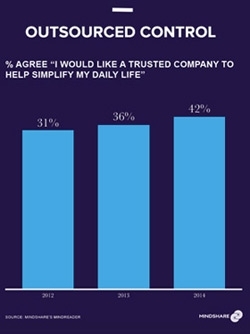 It appears
technology is at a tipping point, where the darker story of tech being bad -- such as robbing us of real human intimacy, social media making us depressed, mobile stunting our kids’ development
-- is giving way to a brighter view, according to Mindshare North America's Culture Vulture trend report that examines what people want, the new companies and technologies that are meeting those
needs, and how brands can find a role to play.
It appears
technology is at a tipping point, where the darker story of tech being bad -- such as robbing us of real human intimacy, social media making us depressed, mobile stunting our kids’ development
-- is giving way to a brighter view, according to Mindshare North America's Culture Vulture trend report that examines what people want, the new companies and technologies that are meeting those
needs, and how brands can find a role to play.
Not only do people want to contribute to good causes -- they also want to make their good intentions widely known online (think the Ice Bucket
Challenge, #givingtuesday), says Mindshare. Brands need to enable consumers to express this desire for caring, such as embracing the popular buy one, give one model or by living how they preach.
Consumers want to know exactly how companies are doing good, how they treat their own employees well, keep their promises, and put people over profits.
advertisement
advertisement
Anywhere, anytime technology means
there are more distractions to deal with in people's lives -- but thankfully, there are increasingly innovative new tools to deal with those distractions. "Yes, technology sometimes means we’re
‘alone together’, but the new intimacies it creates through FaceTime, or the sharing economy, balance this out by far," says Mark Potts, head of insights, Mindshare North America. "And
yes, our kids are sometimes buried in screens, but, as the Oxford developmental neuroscientist Dorothy Bishop points out: if we really want to discourage our kids from losing themselves in two
dimensional surfaces, we should be discouraging them from reading books."
The report also details how an increasing number of consumers want brands and tools to help them ‘outsource
control’ in their daily lives. They want products and services that provide a benefit to them. Specifically, the study found that the percentage of Americans who "would like a trusted company to
help simplify my daily life” has increased from 31% in 2012 to 42% today.
The Acorns app is one example of that kind of company. It keeps track of user’s purchases and invests the
change from those purchases into a savings or investment account. Similarly, iBag is a program that prevents users from accessing their digital wallets, thus preventing unwise purchases. These
services are likely to become even more prevalent and popular over the coming months, per the study.
Meanwhile, consumers are becoming more savvy to everyday marketing tactics, and now they
are gaming the system. For instance, 31% say “when shopping online, I’ll intentionally leave items in a ‘shopping basket’ in hopes of receiving a discount from the
store.” And 47% try to time their travel purchases to when they think prices will be lower.
"It was surprising to see the extent to which marketing is seemingly becoming a game for
many consumers," says Potts. "Millennials in particular feel that they can outsmart marketing (48% of Millennials feel they’re smarter than most marketing done by brands). You know if you tweet
at a brand it’ll be more effective than calling their customer service line. That if you hold items in your shopping basket online, you’re likely to get served an offer down the line. The
question is – will this impact the effectiveness of these strategies?"
These savvier consumers make it harder for brands to advertise to them. The percentage of Americans who say
advertising helps them learn about products and services has dropped from 52% in 2005 to 41% in 2014. Likewise, those who say they read ads in magazines out of curiosity has dropped from 31% in 2005
to 23% today and the percentage of people who like TV ads that make them laugh has declined from 74% to 62% over the same time frame.
Ultimately, brands need to understand that people know how
the game works and either play up to their knowledge or help them step out of the game.
With regard to the consumption of information, the report found that a third of Americans feel
pressure to stay up to date on the latest news, but also don’t have time to read all the articles they want. To cope with that, people skim the surface -- 47% of Americans “prefer to
browse the headlines rather than read detailed information.” But there’s also growing market for content with more substance.
The study also reports that brands will
increasingly use “multi-sensorial experiences” as they reach out to consumers as one solution to fragmented audiences and split consumer attention. Brands will marry technology to the
senses to create stronger brand experiences. Per the study, psychologists have found that using more of our senses increases engagement and memory of content. From virtual reality to 4D and more,
brands can use creative media in new ways to stimulate consumer senses. Already, Volvo, Nissan, and Dos Equis have incorporated virtual reality into promotions, and Marriott and Ralph Lauren have
developed 4D experiences.
This is the agency's fourth annual trend report that identifies macro and micro trends that impact the marketing and communications strategies of the
agency’s clients. The North American version utilizes a Mindshare proprietary survey, Mindshare’s proprietary network of “leading edge” consumers in cities across North
America, and third party resources, including government data, syndicated sources and behavioral data.